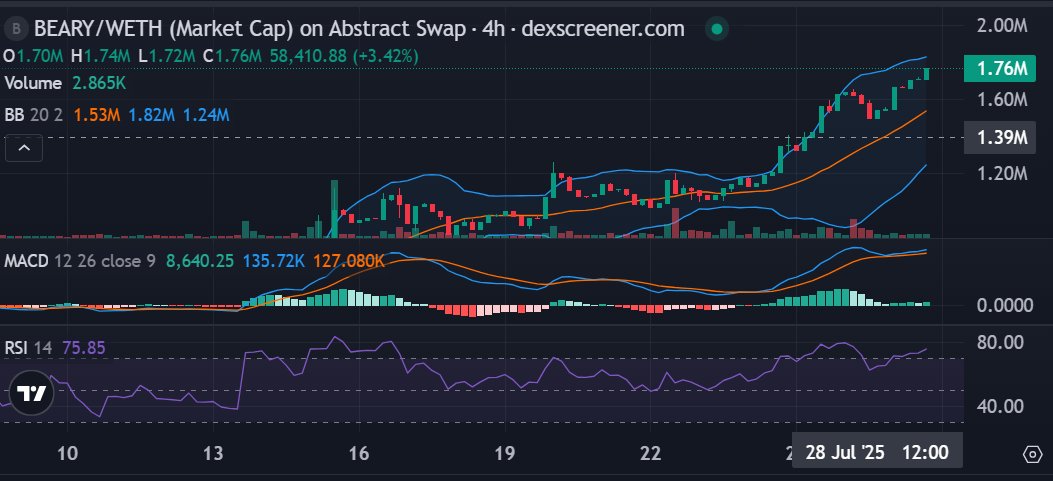Crypto and NFT Market Analysis: Key Trends and Insights (July 27, 2025)
Introduction: A Snapshot of the Crypto and NFT Landscape
The cryptocurrency and NFT markets continue to evolve rapidly, with new projects, collaborations, and technological advancements shaping the future of Web3. This report analyzes key trends, project developments, and market movements observed on July 27, 2025, providing insights into the current state of the industry.
—
1. Market Performance and Technical Analysis
$BEARY Hits New All-Time High (ATH)
The $BEARY token recently reached a new all-time high (ATH) with strong support building above the 1.5M mark. However, the Relative Strength Index (RSI) indicates overbought conditions, suggesting a potential correction. Traders are closely monitoring the 1.3M zone as a potential re-entry point. The upcoming NFT collection launch could reignite momentum, pushing the price beyond the 2M mark.
Waveform Analysis: Top Performing Coins
A waveform analysis conducted on July 27, 2025, highlighted several high-performing coins, including:
– $BLAST
– $SPA
– $VINE
– $C
– $ERA
– $XLM
– $BCH
– #EGL1
– $BONK
– $FLOKI
– $SYRUP
– $TON
– $XRP
– $ETH
– $SOL
– $NFT
– $XMR
– $LTC
– $BNB
– $TRX
– $BTC
These coins exhibited strong momentum, making them key players in the current market cycle.
—
2. Narrative Mindshare: Dominance of Layer-1 (L1) Blockchains
A recent analysis of narrative mindshare revealed that Layer-1 (L1) blockchains captured 28.6% of market attention. Unlike NFT-driven narratives, this trend was influenced by social analysis rather than market movements. Ethereum ($ETH) led with 31.5% mindshare, followed by Bitcoin ($BTC), Solana ($SOL), and other major L1 projects.
—
3. Project Spotlights: Key Developments
Sui (SUI) – A High-Throughput Layer-1 Blockchain
Sui, a high-performance Layer-1 blockchain powered by the Move programming language, continues to gain traction. Its object-centric data model enables parallelism, low latency, and ultra-low transaction fees, making it ideal for DeFi and NFT scaling. The project’s focus on efficiency positions it as a strong competitor in the L1 space.
HIP KONGZ (HIP) – The Next Big NFT Project
HIP KONGZ is part of the Brave Kongz PFP project, introducing a fictional NFT character set to debut as a hip-hop artist. The project’s unique narrative and strong community engagement make it a promising addition to the NFT ecosystem.
Fantasy Top – Expanding to Monad Layer 1
Fantasy Top, a SocialFi and GameFi project, initially launched on Ethereum and Blast, is now expanding to the Monad Layer 1 blockchain. Leveraging Monad’s high transaction speed and low costs, Fantasy Top aims to enhance its NFT card game experience, simulating fantasy battles with strategic gameplay.
—
4. Strategic Collaborations: Irys and OpenSea
A potential collaboration between Irys and OpenSea could revolutionize NFT storage solutions. Currently, OpenSea relies on IPFS and centralized servers for NFT metadata, which poses risks of data loss and censorship. Irys offers a permanent, decentralized storage solution, ensuring long-term security and accessibility for NFTs.
—
5. Tools for Crypto and NFT Enthusiasts
Zelatha, a platform designed for Web3 enthusiasts, provides over 30 powerful tools, including:
– Smart Contract Analysis
– Whale & Market Trackers
– Auto Alerts & Insights
– NFT Design, Minting & Earnings
These tools empower users to navigate the crypto and NFT markets with greater efficiency and confidence.
—
Conclusion: The Future of Crypto and NFTs
The crypto and NFT markets are experiencing rapid innovation, with new projects, collaborations, and technological advancements driving growth. Key trends include the dominance of Layer-1 blockchains, the rise of NFT-driven narratives, and strategic partnerships enhancing decentralized infrastructure.
As the industry continues to evolve, investors and enthusiasts must stay informed about emerging opportunities and risks. The next wave of adoption will likely be shaped by scalability, interoperability, and user-centric experiences, making it an exciting time for Web3.
—
Sources

